Channel Modeling and Analysis for the Sensor Network Inside Tower Buildings
Abstract
:1. Introduction
- (1)
- For performance evaluation of the WSN inside tower buildings, a cluster-based propagation channel model inside tower structure buildings is proposed based on the ray-based channel model, which greatly reduces the complexity to analyze the performance of the communication system.
- (2)
- An improved k-means algorithm is developed to cluster the channel, which could obtain approximately equivalent channel impulse response (CIR) with a ray-based channel model. The channel parameters such as cluster delay and cluster power are equivalently calculated according to the clustered rays. Moreover, the performance of WSN, i.e., BER and channel capacity are derived.
- (3)
- The simulation results for different positions at different heights of the reconstructed tower building at 1 GHz show that the cluster classification method and cluster parameter calculation method can get more approximate equivalent CIR, and the calculated BER on this basis is in good agreement with the theoretical results, which verifies the accuracy of the cluster model and theoretical derivation.
2. Channel Model Inside Tower Buildings
3. Channel Clustering and Performance Analysis
3.1. ML-Based Channel Clustering
3.2. Cluster-Based Channel Parameters
3.3. Equivalent Performance Evaluation
4. Simulation Results and Validation
5. Conclusions
Author Contributions
Funding
Institutional Review Board Statement
Informed Consent Statement
Data Availability Statement
Conflicts of Interest
References
- You, G.; Zhu, Y. Structure and Key Technologies of Wireless Sensor Network. In Proceedings of the Cross Strait Radio Science & Wireless Technology Conference (CSRSWTC), Fuzhou, China, 13–16 December 2020; pp. 1–2. [Google Scholar]
- Jawhar, Q.; Thakur, K.; Singh, K.J. Recent Advances in Handling Big Data for Wireless Sensor Networks. IEEE Potentials 2020, 39, 22–27. [Google Scholar] [CrossRef]
- Farsi, M.; Elhosseini, M.A.; Badawy, M.; Ali, H.A.; Eldin, H.Z. Deployment Techniques in Wireless Sensor Networks, Coverage and Connectivity: A Survey. IEEE Access 2019, 7, 28940–28954. [Google Scholar] [CrossRef]
- Qi, N.; Miridakis, N.I.; Xiao, M.; Tsiftsis, T.A.; Yao, R.; Jin, S. Traffic-aware two-stage queueing communication networks: Queue analysis and energy saving. IEEE Trans. Commun. 2020, 68, 4919–4932. [Google Scholar] [CrossRef] [Green Version]
- Zhaona, C. Analysis on Construction Technology and Quality Control Measures of Building Steel Structure. In Proceedings of the International Conference on Urban Engineering and Management Science(ICUEMS), Sanya, China, 29–31 January 2021; pp. 306–309. [Google Scholar]
- Huang, Z.; Li, Y.; Chen, R.; Yang, M. Clustering Analysis of Multipath Components in Urban Road Scenario for C-V2X Propagation Channels. In Proceedings of the International Symposium on Antennas, Propagation and EM Theory (ISAPE), Hangzhou, China, 3–6 December 2018; pp. 1–3. [Google Scholar]
- Ning, G.; Ma, S.; Guo, Y.; Wang, Q. Prediction of Indoor Wireless LAN Field Strength Distribution Based on Ray Tracing Method. In Proceedings of the 2019 4th International Conference on Mechanical, Control and Computer Engineering (ICMCCE), Hohhot, China, 24–26 October 2019; pp. 656–6563. [Google Scholar]
- Wen, J.; Zhang, Y.; Yang, G.; He, Z.; Zhang, W. Path Loss Prediction Based on Machine Learning Methods for Aircraft Cabin Environments. IEEE Access 2019, 7, 159251–159261. [Google Scholar] [CrossRef]
- Cuinas, I.; Sanchez, M.G. A Comparison of Empirical and Ray-Tracing Models for Indoor Radio-Wave Propagation [Wireless Corner]. IEEE Antennas Propag. Mag. 2020, 62, 107–115. [Google Scholar] [CrossRef]
- Li, Y.; Zhang, J.; Tang, P.; Tian, L. Clustering in the wireless channel with a power weighted statistical mixture model in indoor scenario. China Commun. 2019, 16, 83–95. [Google Scholar] [CrossRef]
- Zhu, Q.; Li, H.; Fu, Y.; Wang, C.H.; Tan, Y.; Chen, X.; Wu, Q. A Novel 3D Non-stationary Wireless MIMO Channel Simulator and Hardware Emulator. IEEE Trans. Commun. 2018, 66, 3865–3878. [Google Scholar] [CrossRef]
- Zhu, Q.; Zhao, Z.; Mao, K.; Chen, X.; Liu, W.; Wu, Q. A Real-Time Hardware Emulator for 3D Non-Stationary U2V Channels. IEEE Trans. Circuits Syst. Regul. Pap. 2021, 68, 3951–3964. [Google Scholar] [CrossRef]
- Kristem, V.; Bas, C.U.; Wang, R.; Molisch, A.F. Outdoor Wideband Channel Measurements and Modeling in the 3–18 GHz Band. IEEE Trans. Wirel. Commun. 2018, 17, 4620–4633. [Google Scholar] [CrossRef]
- Pratschner, S.; Blazek, T.; Groll, H.; Caban, S.; Schwarz, S.; Rupp, M. Measured User Correlation in Outdoor-to-Indoor Massive MIMO Scenarios. IEEE Access 2020, 8, 178269–178282. [Google Scholar] [CrossRef]
- He, R.; Ai, B.; Molisch, A.F.; Stuber, G.L.; Li, Q.; Zhong, Z.; Yu, J. Clustering Enabled Wireless Channel Modeling Using Big Data Algorithms. IEEE Commun. Mag. 2018, 56, 177–183. [Google Scholar] [CrossRef]
- Antonescu, B.; Moayyed, M.T.; Basagni, S. Outdoor mmWave Channel Propagation Models using Clustering Algorithms. In Proceedings of the International Conference on Computing, Networking and Communications (ICNC), Big Island, HI, USA, 17–20 February 2020; pp. 860–865. [Google Scholar]
- Bhaumik, S.; Prokes, A.; Chandra, A. Combined K-Means and Amplitude Clustering of Impulse Response for 60 GHz Vehicular Channels. In Proceedings of the International Symposium on Wireless Communication Systems (ISWCS), Lisbon, Portugal, 28–31 August 2018; pp. 1–5. [Google Scholar]
- Vuokko, L.; Vainikainen, P.; Takada, J.-I. Clusters extracted from measured propagation channels in macrocellular environments. IEEE Trans. Antennas Propag. 2005, 53, 4089–4098. [Google Scholar] [CrossRef]
- Ning, B.; Li, T.; Mao, K.; Chen, X.; Wang, M.; Zhong, W.; Zhu, Q. A UAV-aided channel sounder for air-to-ground channel measurements. Phys. Commun. 2021, 47, 101366. [Google Scholar] [CrossRef]
- Gan, M.; Xu, Z.; Mecklenbräuker, C.F.; Zemen, T. Cluster lifetime characterization for vehicular communication channels. In Proceedings of the European Conference on Antennas and Propagation (EuCAP), Lisbon, Portugal, 13–17 April 2015; pp. 1–5. [Google Scholar]
- Huang, C.; He, R.; Ai, B.; Yang, M.; Geng, Y.; Zhong, Z. Clustering Performance Evaluation Algorithm for Vehicle-to-Vehicle Radio Channels. In Proceedings of the European Conference on Antennas and Propagation (EuCAP), Copenhagen, Denmark, 15–20 March 2020; pp. 1–4. [Google Scholar]
- Lin, J.; Li, D.; Zhang, S.; Zhu, J. DOA Clustering-based Channel Estimation for Mitigating Pilot Contamination in Massive MIMO System. In Proceedings of the International Conference on Wireless Communications and Signal Processing (WCSP), Nanjing, China, 21–23 October 2020; pp. 945–950. [Google Scholar]
- Huang, Z.; Cheng, X. A General 3D Space-Time-Frequency Non-Stationary Model for 6G Channels. IEEE Trans. Wirel. Commun. 2020, 20, 535–548. [Google Scholar] [CrossRef]
- Yesilbudak, M. Clustering analysis of multidimensional wind speed data using k-means approach. In Proceedings of the IEEE International Conference on Renewable Energy Research and Applications (ICRERA), Birmingham, UK, 20–23 November 2016; pp. 961–965. [Google Scholar]
- Zhang, J.; Liu, L.; Fan, Y.; Zhuang, L.; Zhou, T.; Piao, Z. Wireless channel propagation scenarios identification: A perspective of machine learning. IEEE Access 2020, 8, 47797–47806. [Google Scholar] [CrossRef]
- Moayyed, M.T.; Antonescu, B.; Basagni, S. Clustering Algorithms and Validation Indices for mmWave Radio Multipath Propagation. In Proceedings of the Wireless Telecommunications Symposium (WTS), New York, NY, USA, 9–12 April 2019; pp. 1–7. [Google Scholar]
- Tingli, X.; Hongiun, W.; Yingchun, S. Hybrid WSN Node Deployment optimization Strategy Based on CS Algorithm. In Proceedings of the Information Technology, Networking, Electronic and Automation Control Conference (ITNEC), Chengdu, China, 15–17 March 2019; pp. 621–625. [Google Scholar]
- Han, Y.; Byun, H.; Yang, B.; Kim, J.H.; Lee, T.H. Optimization of Sensor Nodes Deployment Based on An Improved Differential Evolution Algorithm for Coverage Area Maximization. In Proceedings of the 2019 IEEE 4th Advanced Information Technology, Electronic and Automation Control Conference (IAEAC), Chengdu, China, 20–22 December 2019; pp. 250–254. [Google Scholar]
- Qi, N.; Xiao, M.; Tsiftsis, T.A.; Yao, R.; Mumtaz, S. Energy efficient two-tier network-coded relaying systems considering processing energy costs. IEEE Trans. Veh. Technol. 2018, 68, 999–1003. [Google Scholar] [CrossRef]
- Ranjan, K.A.; Sehgal, A.; Singh, P.K.; Singh, D.K. BER Based Impact Analysis of Jamming Signals for Fading Channels. In Proceedings of the International Conference on Automation and Computational Engineering (ICACE), Greater Noida, India, 3–4 October 2018; pp. 224–228. [Google Scholar]
- Dawa, M.; Kaddoum, G.; Herceg, M. A Framework for the Lower Bound on the BER of DCSK Systems Over Multi-Path Nakagami-m Fading Channels. IEEE Trans. Circuits Syst. II Express Briefs 2019, 67, 1859–1863. [Google Scholar] [CrossRef]
- Jihua, H.; Shikai, S.; Xingyuan, C. Modeling and Studying of the 16-QAM Based System over the Fading Channel. In Proceedings of the IEEE 3rd International Conference on Cloud Computing and Internet of Things (CCIOT), Dalian, China, 20–21 October 2018; pp. 214–216. [Google Scholar]
- Li, K.; Ingram, M.A.; Nguyen, A.V. Impact of clustering in statistical indoor propagation models on link capacity. IEEE Trans. Wirel. Commun. 2002, 50, 521–523. [Google Scholar]
- Li, S.; Liu, Y.; Yao, L.; Cao, W. Improved Channel Model and Analysis of the Effect of Bodies in Curved Tunnel Using Ray Tracing. IEEE Antennas Wirel. Propag. Lett. 2020, 19, 1162–1166. [Google Scholar] [CrossRef]
- Li, J.; Jiang, D.; Zhang, X. DOA Estimation Based on Combined Unitary ESPRIT for Coprime MIMO Radar. IEEE Commun. Lett. 2017, 21, 96–99. [Google Scholar] [CrossRef]
- Aslam, A.; Qamar, U.; Khan, R.A.; Saqib, P. Improving K-Mean Method by Finding Initial Centroid Points. In Proceedings of the 2020 22nd International Conference on Advanced Communication Technology (ICACT), Phoenix Park, Korea, 16–19 February 2020; pp. 624–627. [Google Scholar]
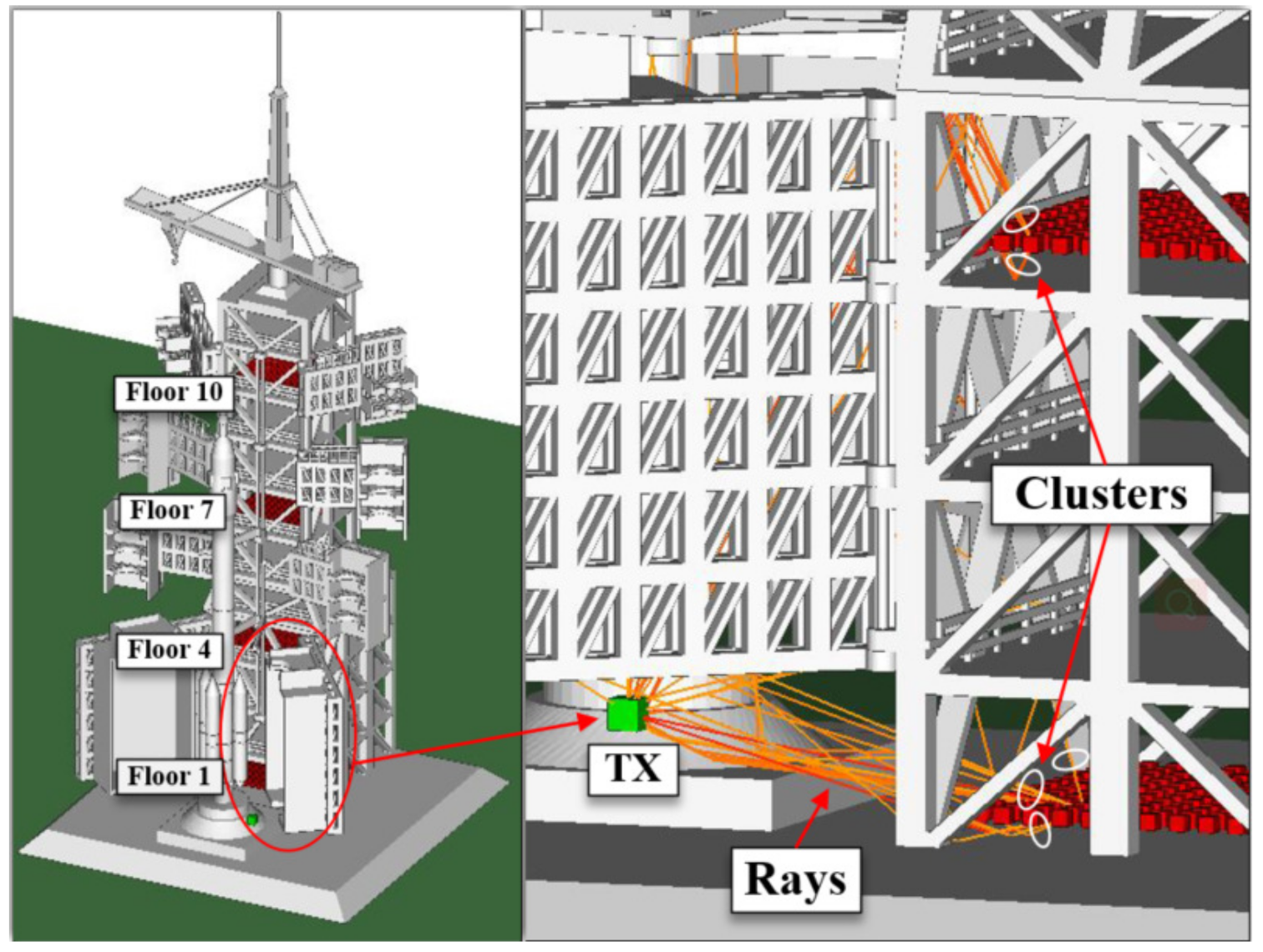
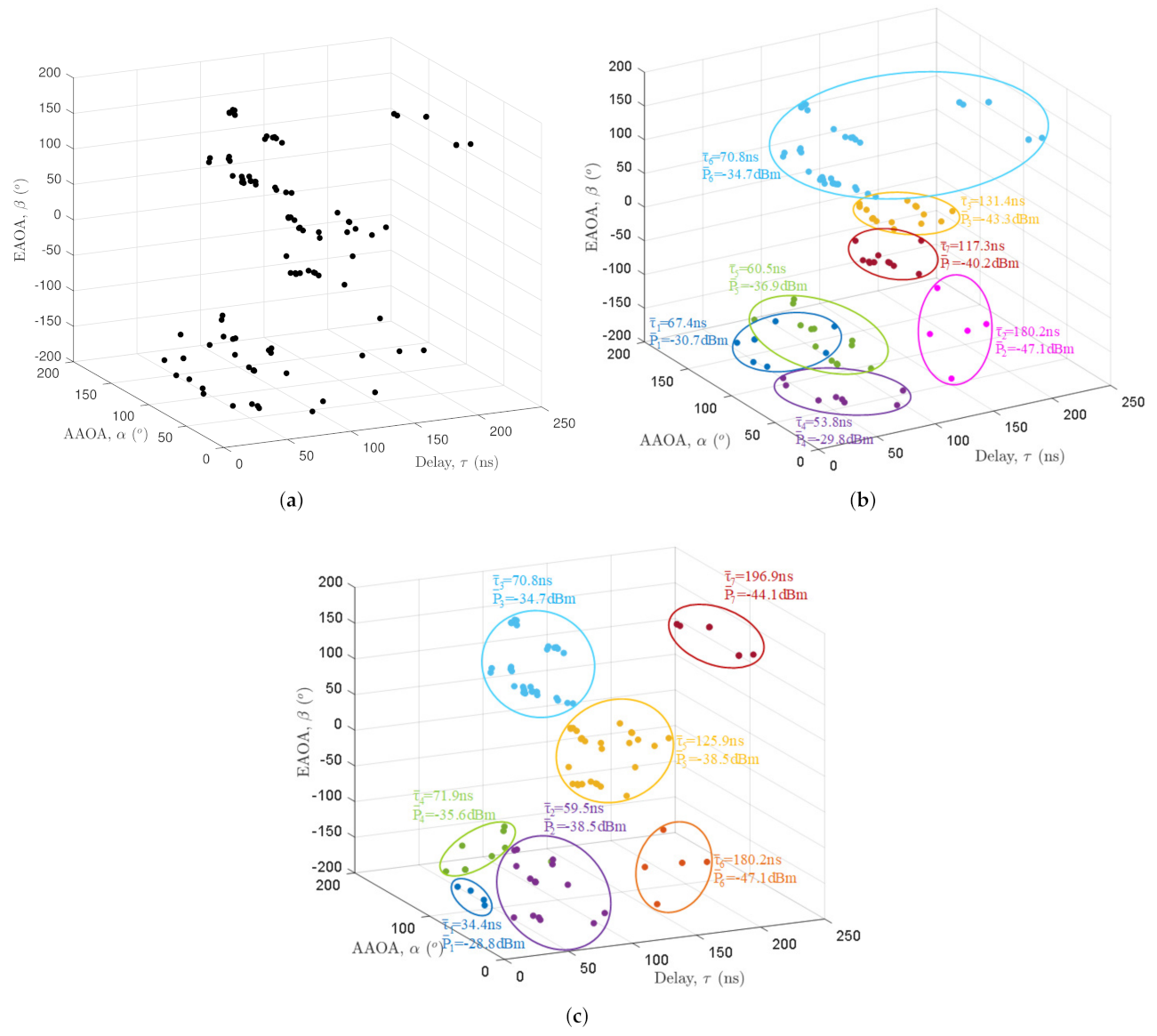
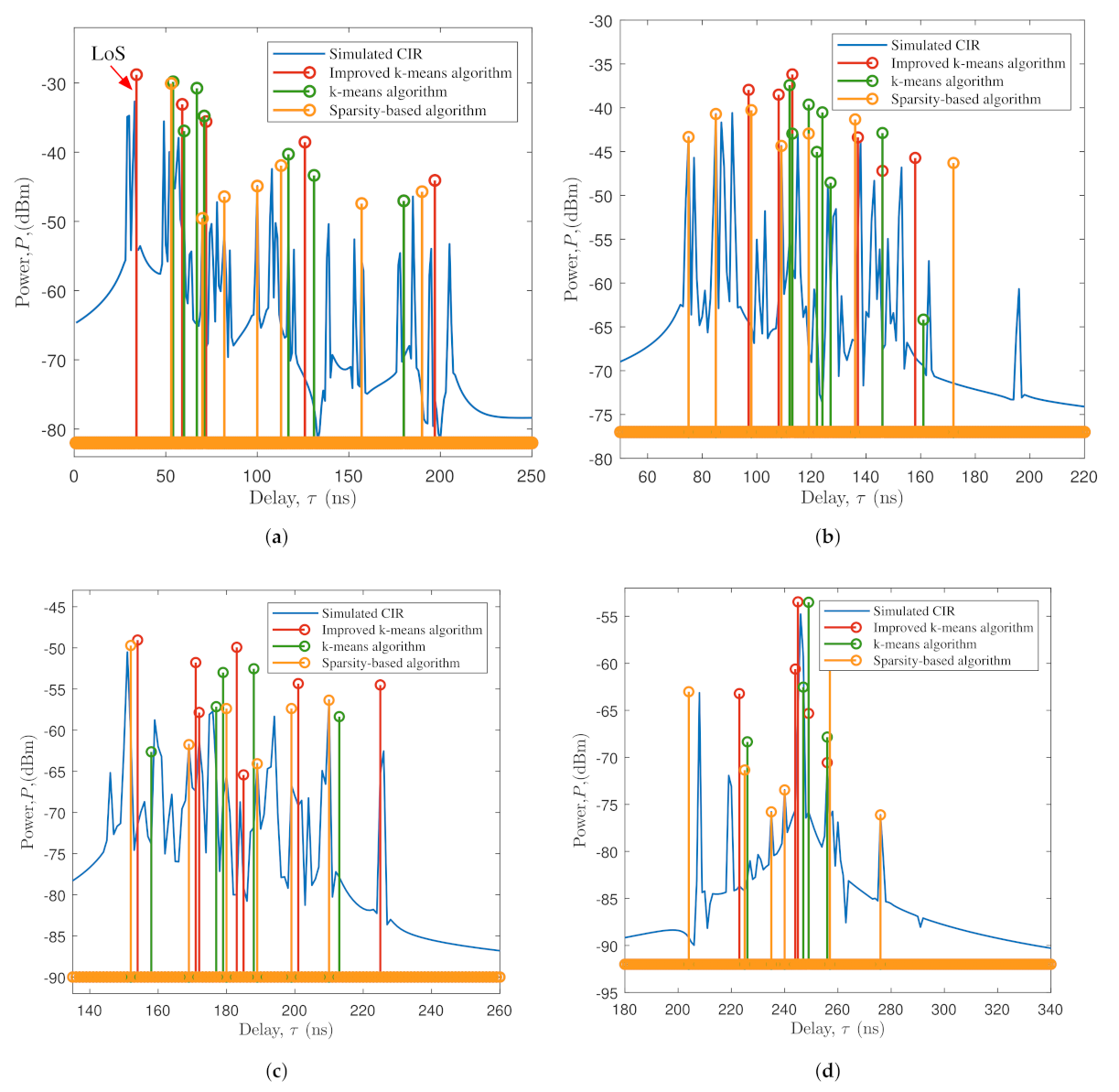
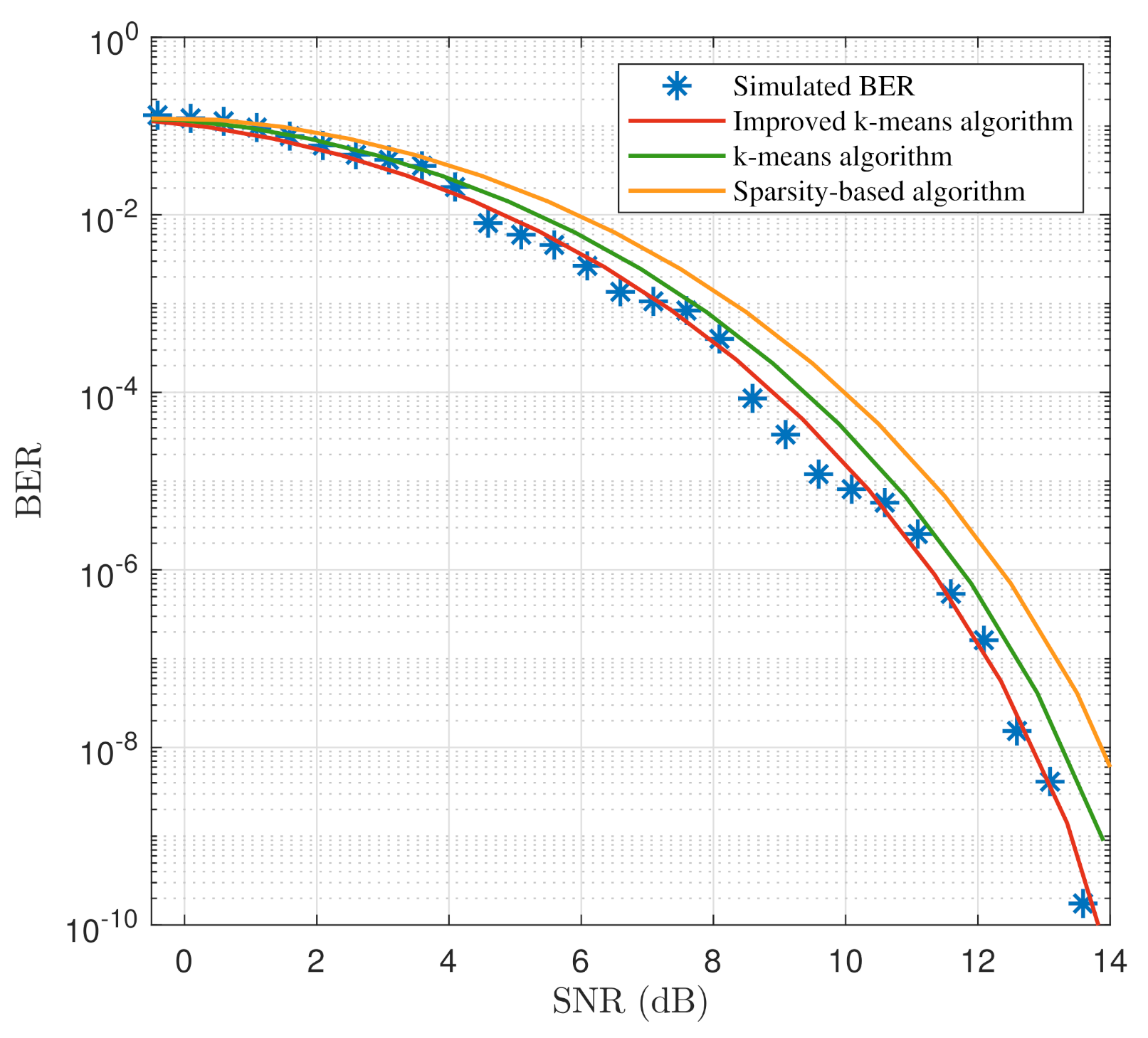
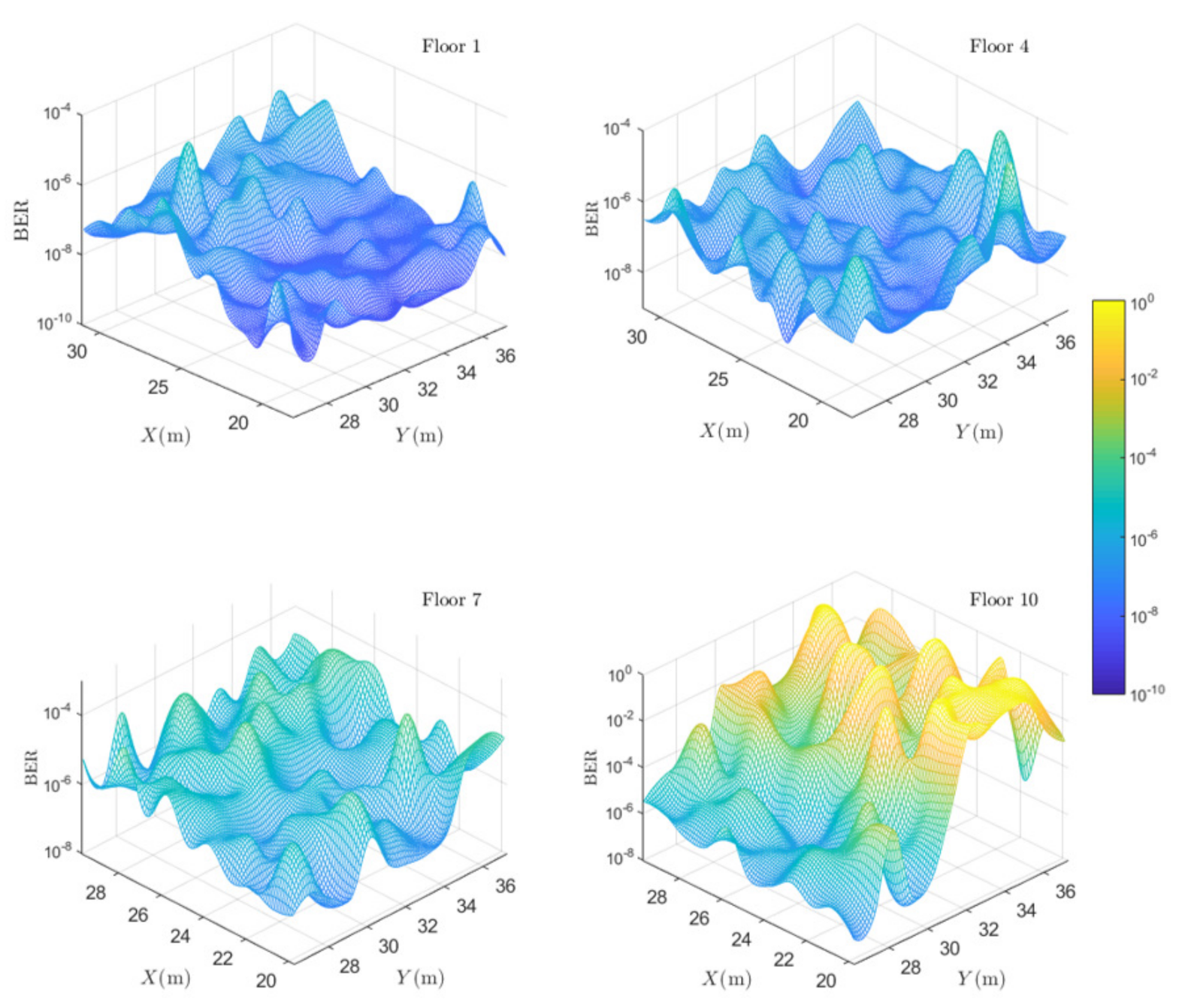
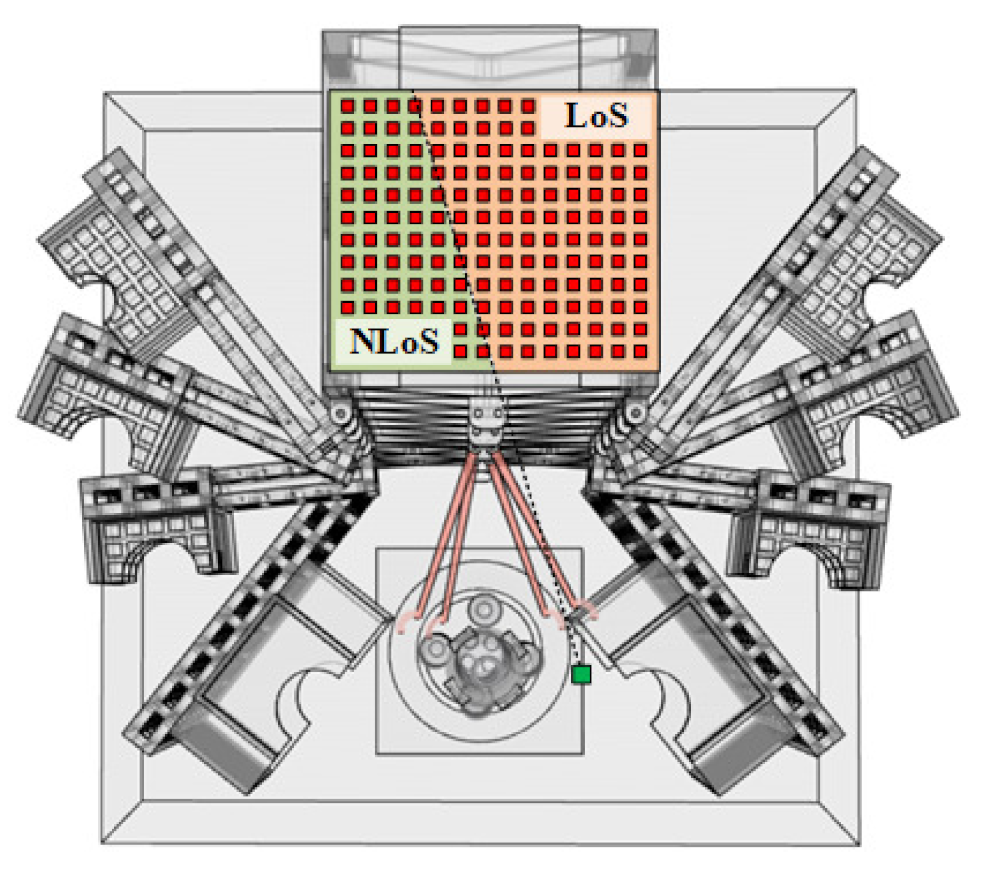
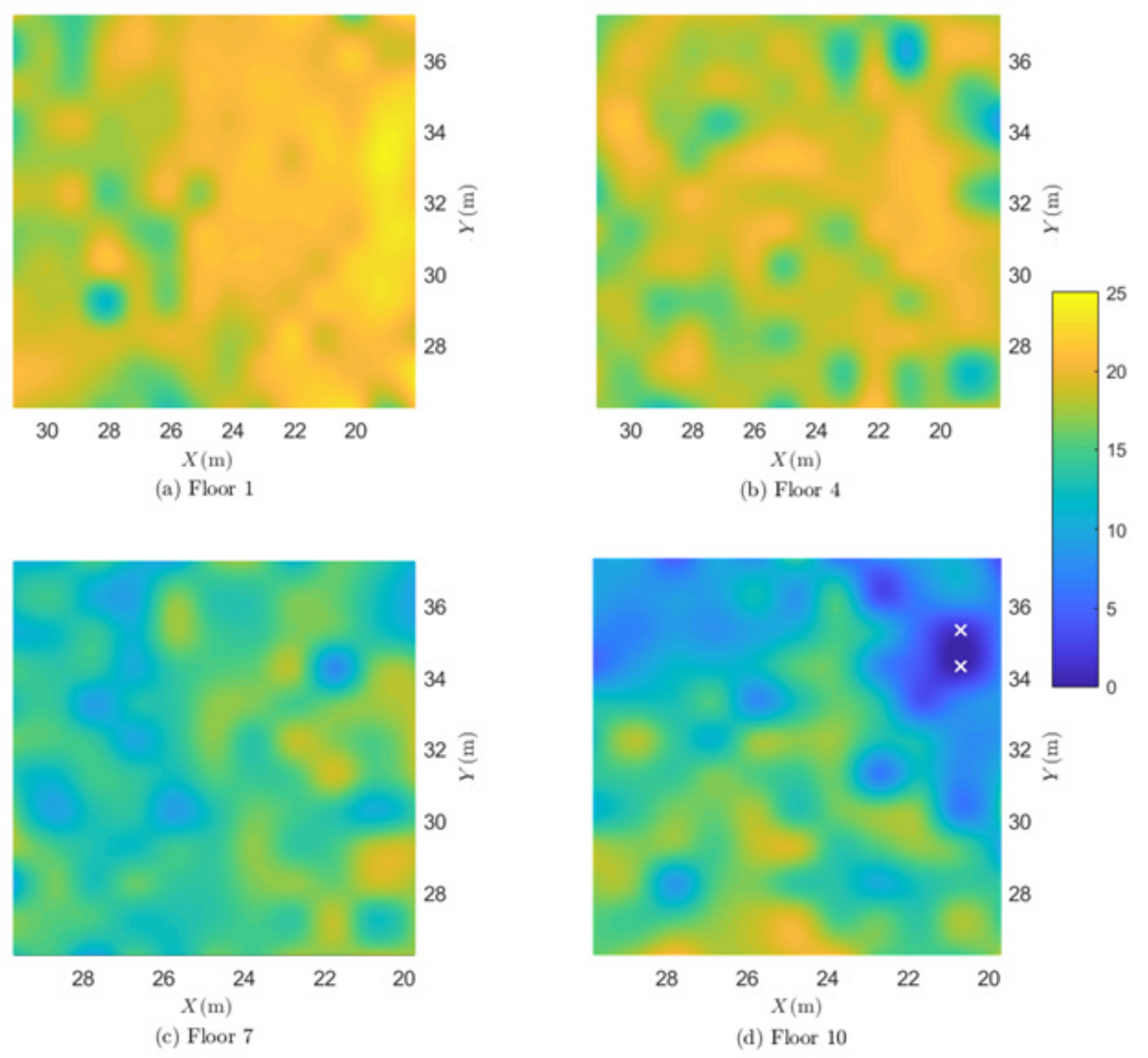
| Clustering Number k | 2 | 3 | 4 | 5 | 6 | 7 | 8 | 9 | 10 |
|---|---|---|---|---|---|---|---|---|---|
| Normalized SSE value of k-means algorithm | 1.00 | 0.52 | 0.26 | 0.29 | 0.32 | 0.16 | 0.18 | 0.17 | 0.16 |
| Normalized SSE value of improved k-means algorithm | 1.00 | 0.35 | 0.37 | 0.33 | 0.48 | 0.11 | 0.14 | 0.13 | 0.12 |
| Parameter | Value |
|---|---|
| Frequency | 1 GHz |
| Transmitting power | 20 dBm |
| Antenna type | Isotropic antenna |
| Polarization type | Vertical polarization |
| TX antenna location | 5 m |
| RX antenna location | 3.5 m, 22 m, 40 m, 58.5 m |
| Simulation material | Metal |
| Maximum number of reflections | 6 |
| Maximum number of diffractions | 1 |
Publisher’s Note: MDPI stays neutral with regard to jurisdictional claims in published maps and institutional affiliations. |
© 2021 by the authors. Licensee MDPI, Basel, Switzerland. This article is an open access article distributed under the terms and conditions of the Creative Commons Attribution (CC BY) license (https://creativecommons.org/licenses/by/4.0/).
Share and Cite
Xie, W.; Chen, X.; Mao, K.; Liu, Y.; Yin, L.; Fang, S. Channel Modeling and Analysis for the Sensor Network Inside Tower Buildings. Symmetry 2021, 13, 2154. https://doi.org/10.3390/sym13112154
Xie W, Chen X, Mao K, Liu Y, Yin L, Fang S. Channel Modeling and Analysis for the Sensor Network Inside Tower Buildings. Symmetry. 2021; 13(11):2154. https://doi.org/10.3390/sym13112154
Chicago/Turabian StyleXie, Wenping, Xiaomin Chen, Kai Mao, Yuxin Liu, Lugao Yin, and Sheng Fang. 2021. "Channel Modeling and Analysis for the Sensor Network Inside Tower Buildings" Symmetry 13, no. 11: 2154. https://doi.org/10.3390/sym13112154
APA StyleXie, W., Chen, X., Mao, K., Liu, Y., Yin, L., & Fang, S. (2021). Channel Modeling and Analysis for the Sensor Network Inside Tower Buildings. Symmetry, 13(11), 2154. https://doi.org/10.3390/sym13112154





